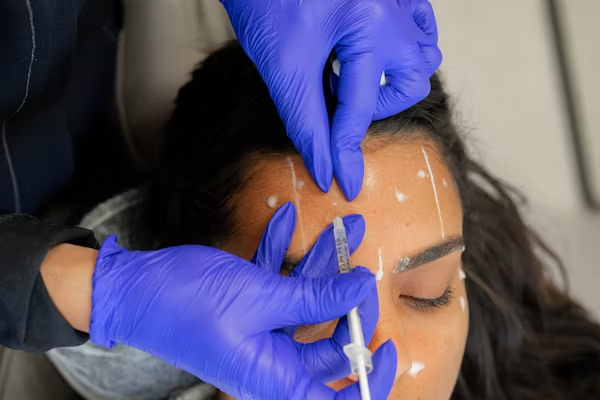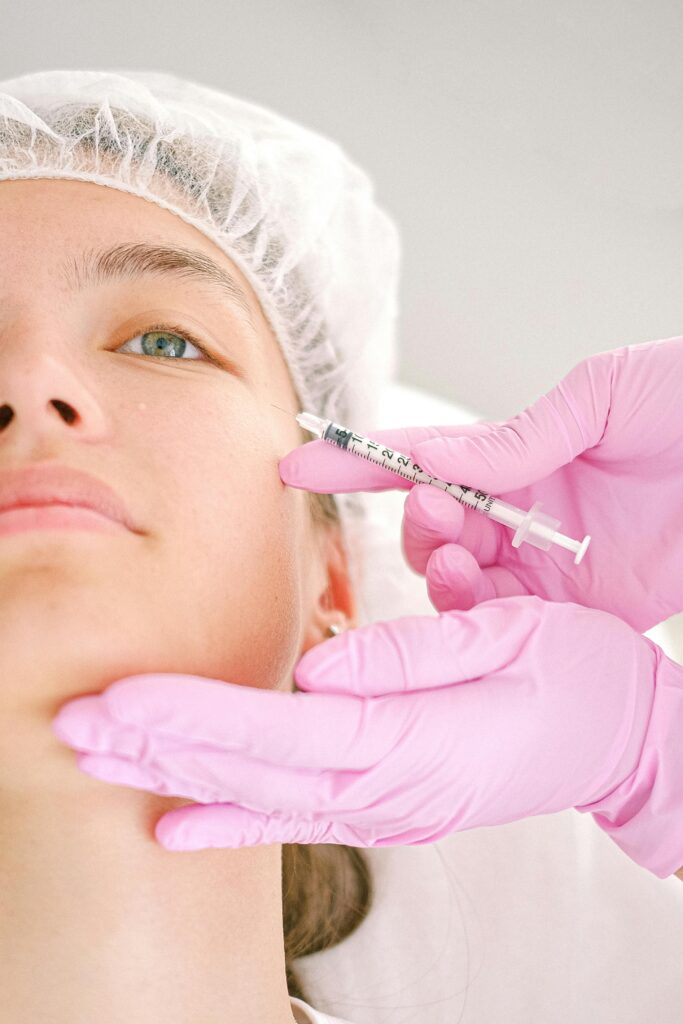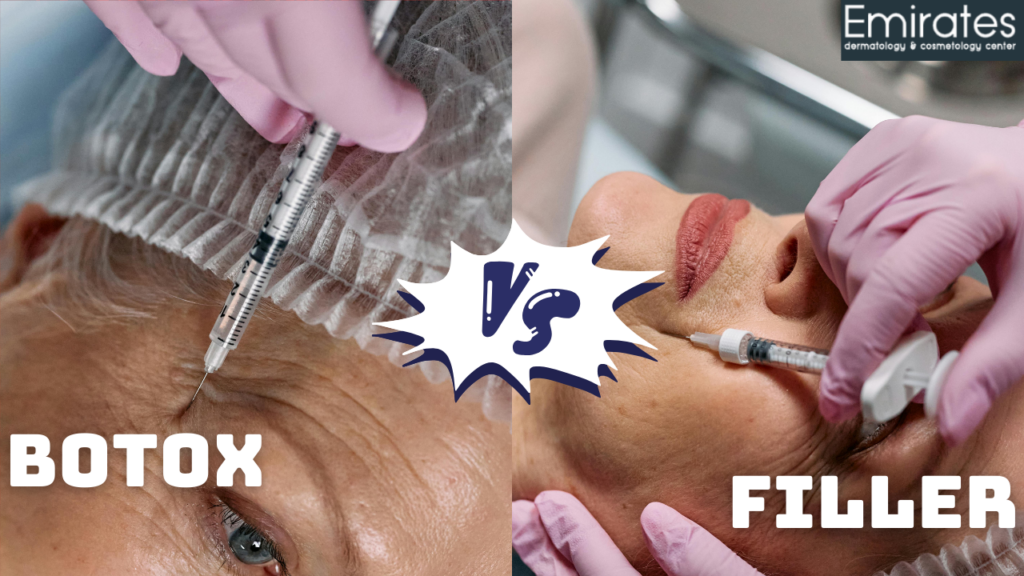Botox and fillers are two of the most popular non-surgical, non-invasive cosmetic procedures to look out for if you’re thinking of removing wrinkles and other skin enhancements. While the end goal is the same, what makes your journey different depending on the procedure you choose? And most importantly, how do you know which procedure would work best for you?
We’ll address these questions here and here’s a comprehensive guide on Botox vs fillers, as you require a proper understanding of both procedures to determine what works best for you.
What is the difference between Botox and dermal fillers?
Botox uses injections of Botulinum toxin to freeze your muscles around the injection site to soften and remove wrinkles. Dermal fillers use injections of hyaluronic acid-based fillers to add volume to the treated areas. While the idea of result is the same, the procedures are fundamentally different from each other.
Except for the fact that both procedures involve injection, everything varies from the substance used, number of sessions, duration, and aftercare. But let’s not get ahead of ourselves. Let’s examine each procedure one by one, understand how they work, and do some comparisons on various aspects.
What is Botox?
Botox, also known as onabotulinumtoxinA, is a specially designed compound used to temporarily improve the skin, especially effective on wrinkles. Botox is the name of the trademarked brand that developed this formula.

Going a bit deep into the technical side, a report by the National Library of Medicine, each vial of Botox® contains 100 Units (U) of Clostridium botulinum type A neurotoxin complex, 0.5 milligrams of Albumin (Human), and 0.9 milligrams of sodium chloride in a sterile, vacuum-dried form without a preservative.
How Does Botox Work?
Wrinkles and lines are formed when there are excessive muscle movements surrounding the skin. The idea of Botox is to make these movements more relaxed. And that’s where it’s ingredients come in.
The main ingredient Clostridium botulinum type A is a bacteria that produces botulinum toxin, which is responsible for the desired results. It’s a neurotoxic protein upon use in very small concentration, cuts the connection between muscles in the injected area and the nerves connecting them. This helps the muscles to be relaxed and consequently it softens the muscle movement. No excessive moments, no wrinkles!
Does Botox Work for Everyone?
Botox is a popular non-invasive procedure that has proved effective for many, including celebrities like Cindy Crawford who have been vocal about Botox in multiple interviews. But like every other procedure, the results you get depends on you.
For first-time users, the effects might not last as long. This is because the muscles are still strong and accustomed to frequent movement. However, with consistent treatments, many people find that their results start lasting longer because the muscles become trained to stay relaxed. Some people develop a natural immunity against the botulinum toxin and this makes Botox less effective for them.
Areas with more muscle activity, such as the forehead, might see Botox wear off faster than less active areas. Then comes the way you do aftercare. If you don’t take care of your skin after the procedure, the effectiveness is in question. And most importantly, the success depends on the expertise of your Botox treatment provider, who must be equipped to strategically place Botox to maximize longevity and maintain a natural look.
What Do Fillers Do?

Now that you’ve got a picture of what is a Botox treatment, let’s move on to fillers. Like Botox, filler treatment also involves a non-invasive injection. But instead of neurotoxins, fillers are used. FIllers constitute hyaluronic acid (HA) or calcium hydroxylapatite that give volume and definition to the site of injection. fillers can plump lips, add cheek volume, and soften deep lines around the mouth.
Botox vs Fillers: Key Differences
The first and most obvious difference is the substance used for injection and the way they work. While Botox effectively freezes your muscles making them less susceptible to excessive movements and this in turn removes wrinkles and lines. Fillers on the other hand plumps up the area making your face look more youthful.
But let’s differentiate Botox and fillers on different aspects.
Target Areas
Botox is best for dynamic wrinkles caused by muscle movement, such as forehead lines, crow’s feet, and frown lines. Fillers are more suitable for static wrinkles and volume loss and are commonly used for plumping lips, contouring cheeks, and filling nasolabial folds.
Results and Longevity
We’ve touched upon this before. Be it Botox or face fillers, the results and longevity depends on your skin, your metabolism, and how you do aftercare. Fillers generally last longer than Botox but the results obtained from Botox are more evident and obvious.
How long does Botox last?
Botox typically lasts 3-6 months after which the effects start to fade. But it depends on several factors. The most important one would be your metabolism, skin type and muscle strength. People with strong, thick facial muscles may require a higher dosage of Botox to see the same effect as someone with naturally weaker muscles. Some people’s metabolism causes breakdown of Botox faster than others, leading to shorter-lasting effects. You can attribute this to age, levels of physical activity, and overall metabolism speed.
How long do fillers stay in your face?
On average, you can see most dermal fillers lasting between six months and two years. Popular brands of fillers Juvederm and Restylane assure at least one year of longevity. Fillers unfortunately fall short to fast metabolism but you can do interim sessions just to amplify its effect. In terms of frequency, fillers are a better option than Botox.
Onset of Results
One of the biggest differences between Botox and fillers is how quickly you see results. If you’re considering these treatments, it’s essential to understand what to expect after your appointment so you can plan accordingly.
How long does Botox take to work?
While the procedure usually doesn’t take more than an hour, the working of the botox compounds inside your body is quite complicated. It takes time for the neurotoxin to block nerve signals to the muscles, leading to a gradual softening of wrinkles.
In short, you wouldn’t be able to see the results immediately and full results may take up to 2 weeks. You can definitely see changes in the first week itself.
How Long Does it Take for Fillers to Work
Unlike Botox, lip fillers give you instant results as you can notice increased volume at the injected site but final results can take up to a week. It also depends on the brand of filler used. Hyaluronic acid-based fillers like Juvederm and Retalyn provide instant volume while collagen-based fillers may take longer to work.
Treatment Experience
Both Botox and fillers are non-surgical cosmetic treatments, and their respective procedures are somewhat similar in terms of the steps you undergo. But the differences lie in the things you do in those steps.
- Consultation: This step involves your initial session with an expert where you discuss your goals. In a Botox consultation, the expert would focus more on your facial muscles whereas in a filler consultation, the emphasis would be on your facial volume.
- Preparation: Both procedures involve cleaning your face. Botox often do not require a numbing cream but in fillers this is usually a requirement. This is because filler injections are slightly uncomfortable and you can find instant change in the volume.
- Injection: Botox is injected into the targeted muscles using a fine needle whereas in a filler procedure, the injection is done beneath the skin.
- Duration: Both procedures usually last 10-15 minutes. For fillers, your cosmetologist may take longer just to observe the instant results, and make any changes accordingly.
- Aftercare: Aftercare for both procedures are slightly different but we’ll discuss that in detail later.
Are There Different Kinds of Botox and Fillers?
Yes. There are several types of Botox as well as fillers. The type of Botox depends on the area on your body you want to work on. The major types are:
- Lip Botox: Following a botox injection on the upper lip, the muscles are relaxed allowing the upper lip to flip outwards. That creates an appearance of a lip with more volume.
- Face Botox: Botox is injected on several areas of the face mostly to reduce wrinkles and face lines. Injecting between brows reduces frown lines, and injection around the eyes reduces the wrinkles when you smile. The most common type is on the forehead where wrinkles form quite easily.
- Sweat Botox: Botox injections are targeted on sweat glands in the armpits, hands, or feel and this is done to reduce excessive sweating.
There are different types of fillers as well but it depends on the constituent used in them. The major types are:
- Hyaluronic acid-based: Hyaluronic acid (HA) is a natural substance found in the fluids especially in the eyes and joints, and acts as a lubricant. Injecting it into the skin enhances the volume of the injected areas. The most popular brands of HA-based fillers are Juvederm and Restylane.
- Calcium Hydroxylapatite-based: Calcium hydroxylapatite is also a naturally occurring substance, especially in bones. The filler based on this compound is the heaviest of facial dermal fillers, and is used to treat moderate to severe skin issues.
- Poly-L-lactic acid-based: Poly-L-lactic acid (PLLA) does not naturally occur in the body, but it is biocompatible and biodegradable. Once injected, PLLA stimulates collagen production rather than simply adding volume like hyaluronic acid fillers. These fillers are excellent for large-area volume loss, like hollow cheeks and deep folds.
Choosing the Right Treatment for You: Filler vs Botox
Now that you’ve understood what botox and fillers are, and what are the notable differences between them, here comes the tricky part. What is the best option for you? You’re spending money and investing time over a treatment and of course you want to choose the right treatment here.
While the answer has to come from you, what we can do is try to help you find the answer. For starters, choosing the right treatment depends on your desired outcome of your look and the skin issues you’re dealing with. Let’s break it down.
First, identify your primary concern. If it’s wrinkles, Botox might be the best option for you. If you’re looking to contour your face, opt for fillers. You can also opt for a customized mix of Botox and fillers for a balanced and youthful look.
Consider your age and skin condition.If you’re in your 20s or early 30s, you have less wrinkles and your skin is more receptive to fillers so Botox might not be needed. You can use fillers for subtle enhancements and even removing wrinkles. Once you’re in your 40s, Botox remains effective for reducing wrinkles. But as you age, you lose volume especially on lips and cheeks so you can use fillers.
Then comes the budget considerations. Botox treatments are generally more affordable per session but require frequent maintenance. Fillers tend to be more expensive upfront, but their longer-lasting results may reduce the frequency of treatments.
After you’ve made up your mind, be sure to consult a cosmetologist that offers both Botox treatments and filler treatments just to make sure that you’ve made the right choice. They can assess your facial structure, skin type, and aesthetic goals to recommend the best treatment for you.
Aftercare Tips for Botox and Fillers
Be it Botox or filler, proper aftercare is absolutely important to achieve the best results and at the same time, minimise side effects. Post-treatment care is essential to make sure the treatment is effective and lasts longer.
Can You Wear Makeup After Botox?
Not right after the procedure, not at least for 24 hours. You run the risk of developing irritations or potential infections if you wear makeup right after the Botox treatment. If you must wear makeup, use clean applicators and gentle products to prevent bacteria transfer.
Post-Treatment Tips
- Avoid touching, rubbing, or massaging the treated area for at least 24 hours.
- Don’t lie down for at least 4 hours after the treatment because you might get a migraine.
- Avoid intense exercise, saunas, and hot showers for 24–48 hours to reduce swelling and bruising.
- Stay hydrated and maintain a healthy diet to support skin healing.
- Avoid alcohol and blood-thinning medications (like aspirin or ibuprofen) before and after treatment to prevent excessive bruising.
Filler Aftercare
Aftercare for fillers are slightly different as you might experience some discomfort in the injected areas. Also because the results are almost instantaneous, you may want to do aftercare to cope up with the immediate changes.
- Apply an ice pack wrapped in a clean cloth for 10–15 minutes every few hours to reduce swelling.
- Sleep with your head elevated to prevent swelling.
- Avoid excessive chewing, kissing, or drinking from straws for 24–48 hours after lip fillers.
Both fillers and Botox offer effective non-surgical treatments to enhance your beauty and deal with issues. While Botox is best for tough wrinkles and lines, fillers are best to enhance volume and symmetry. Everything from steps of procedure and aftercare differs so be sure to do good research on both, to find what’s the best treatment exclusively for you. Compare your findings with your own goals and skin conditions.
But always take the final word from experts. Book a consultation with us today to discover whether Botox, fillers, or a combination is right for you.


